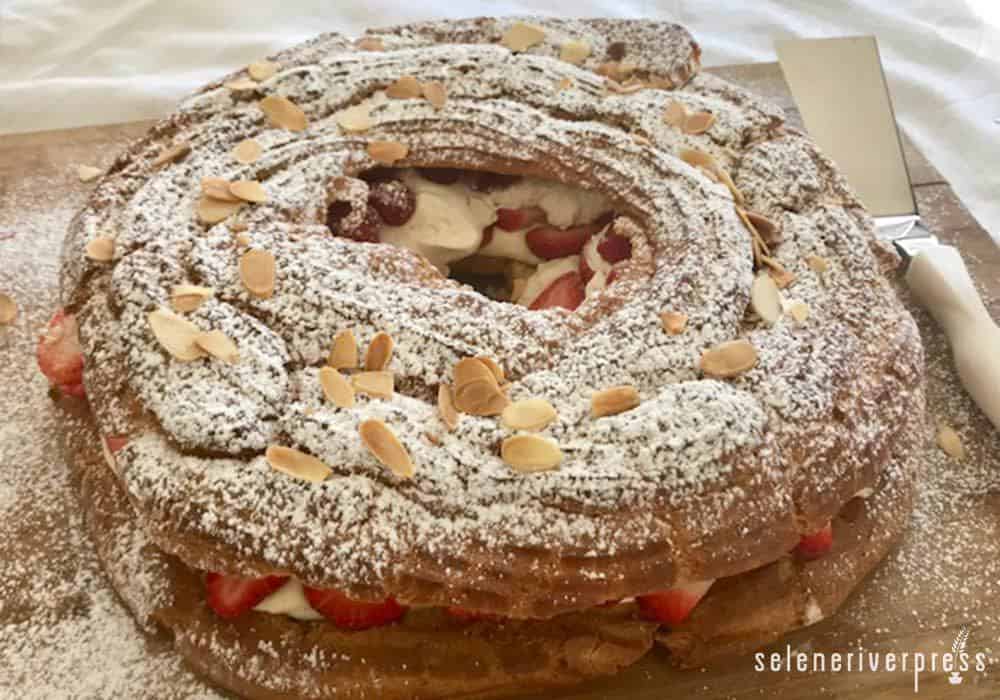I was eleven when I began training under a French pastry chef named Pascal. He graciously took me under his wing because he recognized my passion for food and art and my eagerness to learn and create. Every Saturday morning, I absorbed Pascal’s vast knowledge in the art of patisserie, preparing fruit tartelettes, croissants, napoleons, and petit fours. And it was here that I was introduced to a process I thought was downright magical: pate a choux (pronounced shoe), also known as choux pastry or choux paste.
This delicate pastry defies most rules of baking that I knew of at the time, relying solely on the powers of steam (plus lots of eggs) rather than yeast, as well as baking powder or other leavening agent to create loft. Pate a choux also has the most interesting method of preparation of any dough or batter I’ve ever come across.
What starts out as a soft, sticky dough enchantingly transforms into a puffed, crispy shell, light as air, with a hollowed, slightly custardy center. I’d watch through the windows of the oven, completely mesmerized, as the paste mysteriously ballooned, transforming from small blobs of battery dough into those crispy, airy shells of deliciousness.
The traditional French pastry is the basis for many well-known confections: cream puffs, eclairs, and the spectacular croquembouche, a classical dessert prepared with tiny cream-filled choux, bound with threads of hard caramel, which is often served at weddings, baptisms, and communions. And one somewhat lesser-known confection, at least on this side of the pond: the Paris-Brest.
Paris-Brest was the brainchild of pastry chef Louis Durand. The year was 1910, and the organizers of a bicycle race (the precursor of the Tour de France) chose Durand to create a dessert to commemorate the event. It just so happened that this race ran from Paris to Brest and back again, hence the name. Chef Durand’s ensuing masterpiece contains a ring of pate a choux, symbolizing a bicycle wheel, filled with a fluffy praline cream. The dessert became an instant classic and is one of France’s most iconic creations.
Since my days as a pastry chef, I’ve made multiple attempts to recreate many of the classical desserts I prepared back at the bakery with healthier ingredients. I’ve had a fair bit of success with some recipes—and with others, not so much. I always had dreams of revamping the classic choux pastry along the same lines, but I didn’t get around to it until recently.
Thanks to the limits of culinary science, it isn’t always possible to overhaul recipes (especially for pastries and other baked goods) with more healthful components, and with fewer sugars and other refined, adulterated ingredients. The fact that I’m at higher altitude also doesn’t help much either. Subbing whole grain flours often results in heavy, dry, crumbly baked goods—an especially unfavorable outcome for delicate pastries. Reducing or substituting sugars by too much can transform the proportions of a recipe to the point that the chemistry simply won’t lead to the proper reaction. You’re left with dense, gummy cakes; sandy, brittle cookies; and flat, weighty biscuits. The bottom line is that we can’t always alter the delicate chemistry of baking to suit our desires.
Gratefully, pate a choux is one of the easier recipes to modify. The pastry already contains a limited amount of sugars. The proportions are on par with a traditional recipe, so the only real issue is swapping whole grain flour for refined white flour. Luckily, there are enough eggs in choux pastry to mostly overrule the added density of whole grain flour. For pastries and more delicate baked goods, I find that whole grain einkorn flour, with its low gluten content, pale color, and similar density to all-purpose flour, results in a pastry that most closely resembles one made with traditional refined flour. The resulting choux is slightly heavier than what I made as a child, but it’s about as close to the real thing as it can get. And when I turn the choux into eclairs and cream puffs bursting with delectable, creamy fillings, few can tell the difference.
When it comes to turning the choux into Paris-Brest, one thing I can’t replicate from the original pastry is the praline cream. Praline, one of my all-time favorite sweet concoctions, is a paste made with nuts and rock-hard caramelized sugar—and lots of it. You simply can’t reproduce it with alternative or reduced sweeteners. So rather than even try, I prepare a more refreshing filling of fresh berries and crème Suisse, a Swiss-style pastry cream thickened with gelatin and lightened with whipped cream. The results are outstanding, and it’s actually pretty healthy to boot!
My updated version of Paris-Brest is a delightful alternative to the more familiar cakes, pies, and tarts served on special occasions. The presentation is beautiful and distinctive, and it makes a grand showstopper of a centerpiece that comes together far easier and quicker than you’d think.
Use your favorite seasonal fresh fruits, allowing them to peek through the sides of the dessert for added visual appeal. The cream filling can also be flavored with espresso or melted chocolate (folding it into the warm pastry cream before chilling is easiest). You can also give it a unique twist with seasoning extracts, citrus zest, or spices.
Paris-Brest with Fresh Berries and Crème Suisse
Note: As with many cakes, most of the components of Paris-Brest need to be fully cooled and then chilled before assembly, so it’s best to prepare everything a day in advance. Finish assembling right before serving.
Makes 1 (10- or 11-inch) pastry
Hands-on time: 45–60 minutes, plus chilling time
Cook time: 1½–2 hours
Special equipment: pastry piping bag or gallon-sized Ziploc, star tube, standing or hand-held mixer, parchment paper, permanent marker, pastry brush, and cake board or large platter
Ingredients
For the pate a choux:
1 cup whole grain einkorn flour
½ teaspoon salt
½ cup unsalted butter (if you use salted butter, omit salt from recipe)
½ cup whole milk
½ cup water
½ teaspoon maple syrup
4 large eggs, lightly beaten, plus 1 additional egg for egg wash
Sliced almonds, for garnish (optional)
For the crème Suisse:
¼ cup arrowroot
2 cups whole milk
3 large egg yolks, plus 1 whole egg
¼–½ cup sweetener of your choice, such as maple syrup, honey, or coconut sugar (this will make a darker custard), or alternative sweeteners, such as powdered inositol or stevia (added to taste)
1½ tablespoons high-quality grass-fed gelatin (I use Great Lakes)
1 tablespoon vanilla
1 tablespoon cold, salted butter
1 cup heavy cream, whipped
For assembly:
3 cups assorted berries
1 recipe each pate a choux and crème Suisse
Powdered inositol or pulverized coconut or maple sugar, for dusting (optional)
Instructions
- Prepare pate a choux: Place rack in center of oven and preheat to 400°F.
- Line a baking sheet with parchment paper. Draw an 8-inch circle with a permanent marker. Flip paper over so marker is visible underneath.
- Sift together flour and salt into a bowl. Bring butter, milk, water, and maple syrup to a boil in a medium-sized pot. Remove from heat and quickly add all the flour to the pot. Stir vigorously with a wooden spoon or heat-proof spatula until the dough comes together. Return pot to stove and cook over medium-low heat, stirring constantly, until the dough starts to dry out and comes away from the sides of the pot in a smooth ball, about 3 minutes.
- Transfer dough to an standing mixer fitted with a paddle attachment or hand-held mixer with the thicker beaters. Beat on low speed for about a minute to release steam. Lightly beat eggs in a small bowl. Once dough is warm, begin adding eggs a little at a time. Continue to mix until you have a smooth, glossy paste. (The dough will separate at first, then come together.)
- Transfer dough to large piping bag fitted with a star tube. If you don’t have a star tube, you can just snip the corner of the bag, though the presentation will not be as pretty. You may use a gallon-sized Ziploc with the corner snipped off.
- Pipe a 1-inch thick ring just inside your traced circle. Pipe another 1-inch ring inside the first one, being sure the rings are touching. Pipe one final ring of dough on the top, over the seam of the two lower rings. (If desired, you can pipe small dollops or 3-inch logs on a second baking sheet with any remaining dough to make cream puffs or eclairs.) Brush final beaten egg atop ring and sprinkle with sliced almonds
- Bake 15 minutes, then reduce oven to 350°F. Bake a further 34–45 minutes, until browned, puffed, and crispy. Don’t open oven door while it bakes, or it could deflate. After 40 minutes, turn off oven. Crack oven door for about 30 minutes so shell can dry out further. Remove from oven and finish cooling on a rack. Cool completely before filling.
- Prepare crème Suisse: Combine arrowroot with ¼ cup cold milk. Set aside. Crack egg yolks into a small bowl (reserve egg whites for another use, if desired). Bring remaining milk and your sweetener of choice to a simmer in a heavy-bottomed pot. Whisk some of the hot milk mixture to the egg yolks to temper them, then return to pot with milk. Heat over medium-low, whisking frequently, until thickened.
- Dissolve gelatin in a couple tablespoons cool water. Add softened gelatin to custard and whisk through to dissolve. Add arrowroot mixture to custard and heat until just thickened, about 1–2 minutes. Don’t boil, or both the gelatin and the arrowroot will lose their power, and the mixture will start to thin out. Add vanilla and cold butter. Whisk through, then transfer mixture to a bowl. Place a sheet of parchment directly atop custard to prevent skin from forming, then cover with plastic wrap. Chill completely, at least 2–3 hours, until set
- When custard is set, whip cream to stiff peaks. Whisk custard to break up firmness. Fold thickened cream into whisked custard, then return mixture to fridge for an hour before using.
- Assemble Paris-Brest: Slice any berries that need it, and keep others whole. Using a sharp serrated knife, slice cooled choux ring in half horizontally. Remove any excess or uncooked dough from inside ring. Place bottom ring on a platter or cake board. Using a piping bag fitted with a star tube (or a spatula), fill ring with about ¾ of the crème Suisse. Scatter with berries, then top with remining crème Suisse. Place top ring over crème Suisse, then dust with inositol or pulverized sugar, if using. Best served immediately, for the crispiest pastry.
Image from Briana Goodall.



